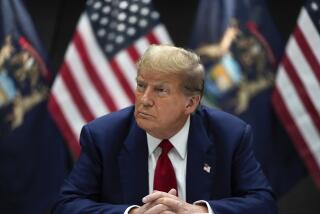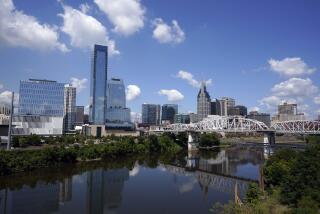Obama’s budget: Taxing for fairness or class warfare?
From front to back and on nearly every page, President Obama’s new budget plan delivers a stark message: It’s time for the rich to lighten the load on the middle class.
In education, healthcare and an array of other proposals, the budget focuses more benefits on middle-class and lower-income Americans and looks to the affluent to help pay for them.
The change is meant to reverse a long-running trend in the opposite direction.
Since President Reagan began an era of tax-cutting in the 1980s, lower-class incomes have stagnated and middle-class incomes have increased only slightly, but the incomes of the richest Americans have skyrocketed, the 134-page budget document points out.
If the country is going to recover from today’s economic crisis, Obama argues, that is going to have to change.
“Throughout our history, the United States has grown and prospered when all Americans have shared in the opportunities created by our economy,” Obama said in the budget overview. (A more detailed formal budget will be sent to Congress in April.)
Some Republicans denounced the priority shift in Obama’s budget as class warfare, and the budget is sure to face several tests as it works its way through Congress. Also, some economists warned that higher taxes on the affluent could reduce their entrepreneurial energy and were unfair because upper-income Americans already pay a large share of the government’s total revenue.
Many other economists think history supports Obama’s argument that the country’s overall prosperity has generally increased when those in the middle did better.
During the economic boom that followed World War II, income inequalities eased as the middle class prospered. One reason was the availability of increasingly well-paying jobs in manufacturing and other booming sectors of the economy. Strong unions were able to negotiate contracts that gave even relatively unskilled workers more than such workers had earned in earlier times.
Also, those in the upper income brackets were heavily taxed. Until the 1980s, the top tax bracket was 70%, though most wealthy Americans found ways to shelter much of their income from the highest rates.
In the 1990s, as manufacturing gave way to an economy based on services and technology, incomes would have become more unequal even without government action, said William G. Gale of the Brookings Institution. But the tax cuts enacted under George W. Bush accelerated the trend.
“If inequality was growing because everyone’s income was growing a lot -- but the rich were just growing faster -- then it might not be that much of an issue,” Gale said. “But what has happened in the last 10 years is that incomes at lower and medium levels have stagnated while the rich have gotten really rich.”
In 1980, the richest 1% of Americans claimed 10% of all national income. In 2004, they claimed more than twice as much -- 22%.
“There’s nothing wrong with making money,” Obama’s budget document said, “but there is something wrong when we allow the playing field to be tilted so far in the favor of so few.”
Obama’s answer is to say that taxes for the rich will need to go back up -- not all the way to the 70%, but to something in between the Bush era and the postwar era.
“What this does is undo the Bush tax cuts. And then it focuses a lot of new things at the middle and the bottom to reverse the inequalities,” said Roberton Williams, senior fellow at the Tax Policy Center.
For example, to help with the rising costs of higher education -- often the key to more-secure and better-paying careers -- the budget proposes to expand and stabilize funding for two signature programs for lower-income students: Pell grants and Perkins loans.
Obama wants to expand the Perkins loans so that 2.7 million more students get them. In another change, access to the loans would be skewed toward colleges that offer more need-based financial aid, which serves poorer kids rather than those from more affluent families.
And it would make permanent the $2,500 American Opportunity Tax Credit -- first passed in this year’s economic stimulus bill -- to help families paying for college.
The budget notes that a dollar of investment in education has been shown to yield social and economic benefits of $4 to $9.
“Obama wants to help people afford college,” Williams said. “His focus is on things that have long-term investment potential and have major, major social benefits.”
Similarly, on healthcare, Obama has decided to put cost control above expanding coverage -- a goal that would have the effect of easing healthcare expenses for everyone, but especially for the middle class. The budget proposal includes a graph showing that while workers’ hourly earnings have increased just 3% since 2000, healthcare premiums have increased 60%.
“Workers’ take-home pay is constrained by health insurance costs to a degree that is both underappreciated and unnecessarily large,” the budget says.
There’s also a shift in investment priorities in the healthcare proposal. The fastest-growing part of the federal budget is spending for Medicare, a program that provides healthcare for the elderly. It is paid for by payroll taxes from people still in the workforce.
In essence, Medicare amounts to a resource shift from younger workers to older retirees. And the population of older retirees is rapidly growing relative to the workforce.
“The more we spend on the elderly, the less we can spend on other things, including education,” Williams said. “We’re doing an awful lot to support consumption in retirement, and that draws resources away from other uses.”
Whereas Williams and others see Obama’s laser-like focus on bolstering the middle class as a long-needed correction, others see in it the seeds of new inequalities.
Brian M. Riedl, a budget analyst at the Heritage Foundation, says Obama’s plan amounts to an unfair redistribution of the tax burden. He said that the top 20% of taxpayers now pay 80% of all taxes collected by the government. And 40% of households pay no income tax.
Under Obama’s plan, he said, the top 20% of tax filers would pay 90% of all taxes, and the number of families who owe no tax would climb to near 50%.
“President Obama is offering a free lunch to a lot of Americans on the backs of 5% of the taxpayers. That can be called class warfare,” Riedl said. “I think a lot of Americans believe that even the rich should not face tax rates that add up to about 50%.”
And Riedl argues that targeting the rich could backfire: “You can only increase taxes on the rich so much before they stop working, saving and investing, and that reduces economic growth for everybody.”
Based on his budget, those arguments are unlikely to gain traction with the president.
“The ladder into the middle class and beyond has become harder and harder to climb,” Obama’s budget says. “The American dream has slowly slipped beyond the grasp of millions as we have deliberately ignored the very investments in our people that strengthen the middle class and neglected the drivers of economic growth that will sustain our economy for the long run.”
More to Read
Start your day right
Sign up for Essential California for news, features and recommendations from the L.A. Times and beyond in your inbox six days a week.
You may occasionally receive promotional content from the Los Angeles Times.






